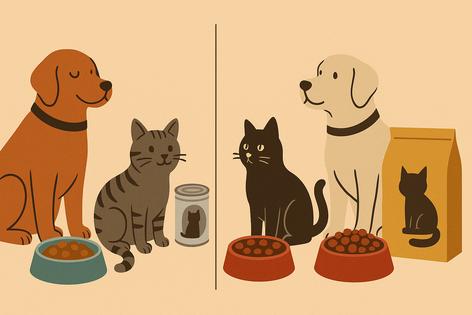The Great Pet Food Debate: Wet vs. Dry for Cats and Dogs
Published in Cats & Dogs News
For pet owners, choosing between wet and dry food can feel like picking sides in an age-old debate. While both forms of pet nutrition offer benefits and drawbacks, the best choice often depends on the pet’s age, health status, lifestyle and—perhaps most importantly—their personal preferences.
Nutrition and moisture content One of the biggest differences between wet and dry food is water content. Wet food typically contains around 70 to 80 percent moisture, while dry kibble contains only 10 to 12 percent. This makes wet food particularly beneficial for pets prone to dehydration or urinary tract issues, especially in cats who naturally have a low thirst drive. Dogs, too, can benefit from the extra hydration in wet food, especially during the summer months or after exercise.
Dry food, on the other hand, offers a more concentrated form of nutrition. Because it contains less water, kibble tends to be more calorie-dense, which can be ideal for pets who need more energy or have smaller appetites. However, this concentration can also lead to overfeeding if portions are not carefully measured.
Dental health and convenience Dry food has long been associated with better dental health. Its crunchy texture helps scrape plaque and tartar from teeth, contributing to better oral hygiene. While it’s not a substitute for brushing or professional cleanings, many veterinarians agree that kibble is generally better for teeth than soft, wet food.
When it comes to convenience, dry food clearly has the upper hand. It’s easier to store, doesn’t require refrigeration after opening and tends to be less messy. For multi-pet households or owners who feed on a schedule, kibble is often the more practical option.
Wet food, while less convenient, is often more palatable. The aroma and texture tend to appeal to picky eaters and can encourage senior pets or animals recovering from illness to eat. It's also easier to chew, which can make it a better choice for pets with dental issues, despite its lack of abrasive texture.
Cost and shelf life Budget-conscious pet owners may lean toward dry food due to its longer shelf life and generally lower cost per serving. Bags of kibble can be stored for weeks, while cans of wet food, once opened, must be refrigerated and used within a few days.
Wet food is more expensive ounce for ounce, and because it’s less calorie-dense, pets often require larger portions to meet their energy needs. Still, for owners willing to make the investment, it can be a valuable part of a balanced diet.
What veterinarians recommend Most veterinarians agree that both wet and dry food can be part of a healthy diet. Some even recommend a combination of the two—wet food for hydration and palatability, dry food for dental health and convenience. The most important factor is the overall nutritional content, not the form the food takes.
"Look for products that meet AAFCO standards and are appropriate for your pet's life stage," said Dr. Natalie Williams, a small animal veterinarian based in Chicago. "Whether it’s wet or dry, the goal is to provide complete and balanced nutrition."
Tailoring the choice to your pet Ultimately, the best food for your cat or dog may not be the one with the most appealing commercial or the highest price tag. It comes down to individual needs. A young, active dog might thrive on high-protein dry food, while an older indoor cat with chronic kidney issues may benefit from a moisture-rich wet diet.
Owners should monitor their pet’s weight, energy level, coat condition and stool quality to assess how well a particular food is working. Regular checkups and conversations with a veterinarian are essential, especially if you’re considering switching types or brands.
The bottom line There’s no one-size-fits-all answer to the wet vs. dry debate. Both types of food have their place in a thoughtful feeding plan. What matters most is that your pet is healthy, happy and well-nourished—whether that comes from a scoop of crunchy kibble or a spoonful of savory stew.
========
This article was created, in part, using AI tools.









Comments